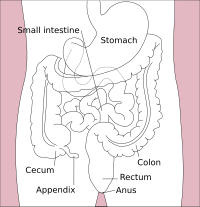
Photo from wikipedia
Abstract Long chain PUFA contents in plasma and liver both exhibited diurnal rhythms in pigs. However, whether mRNA expression of amino acid transporter and circadian gene Cry in intestinal mucosa… Click to show full abstract
Abstract Long chain PUFA contents in plasma and liver both exhibited diurnal rhythms in pigs. However, whether mRNA expression of amino acid transporter and circadian gene Cry in intestinal mucosa is also rhythmic is yet to be known. The purpose of this study aims to investigate the diurnal rhythm in mRNA expression of genes encoding amino acid transporter and whether their rhythm was related to the expression of circadian gene Cry in intestinal mucosa of piglets. Thirty-six piglets (Duroc × Landrace × Large Yorkshire) at the age of 35 days were selected and fed for three weeks, and then samples were collected at 3:00 am (Clo3), 7:00 am (Clo7), 11:00 am (Clo11), 3:00 pm (Clo15), 7:00 pm (Clo19), and 11:00 pm (Clo23) at the age of 56 days. At each time point, small intestinal mucosa samples were collected from duodenum, jejunum, and ileum for detection of mRNA expression of the amino acid transporters and circadian gene Cry. The results showed that mRNA expression of most amino acid transporters in intestinal mucosa was higher at night and lower during the daytime. Expression of SLC1A2, SLC6A20, SLC7A1, and SLC6A14 in duodenal mucosa reached the peak at Clo3 and Clo7; the diurnal rhythm of expression of SLC1A2, SLC6A20, and SLC7A1 was similar to Cry1, while the diurnal rhythm of expression of SLC6A14 had a similar trend to Cry2. Expression of SLC16A10, SLC1A2, and SLC7A1 in jejunal mucosa reached the peak at Clo7, while SLC6A14 reached the peak at Clo3; the diurnal rhythm of expression of SLC1A2 showed a similarity with Cry1, while the diurnal rhythm of expression of SLC16A10, SLC7A1, and SLC6A14 was similar to Cry2. Expression of SLC6A14, SLC6A20, and SLC7A1 in ileal mucosa reached the peak at Clo3; the diurnal rhythm of expression of SLC6A20 has a similarity with Cry1, while the diurnal rhythm of expression of SLC7A1 and SLC6A14 was similar to Cry2. The results suggested that the mRNA expression of most genes encoding amino acid transporters exhibited diurnal rhythms in the intestinal mucosa of piglets, and SLC7A1, SLC6A14, and SLC1A2 have a similar rhythm with circadian clock genes Cry1 and 2, and they reached the peak at Clo3 and Clo7.
Journal Title: Biological Rhythm Research
Year Published: 2017
Link to full text (if available)
Share on Social Media: Sign Up to like & get
recommendations!